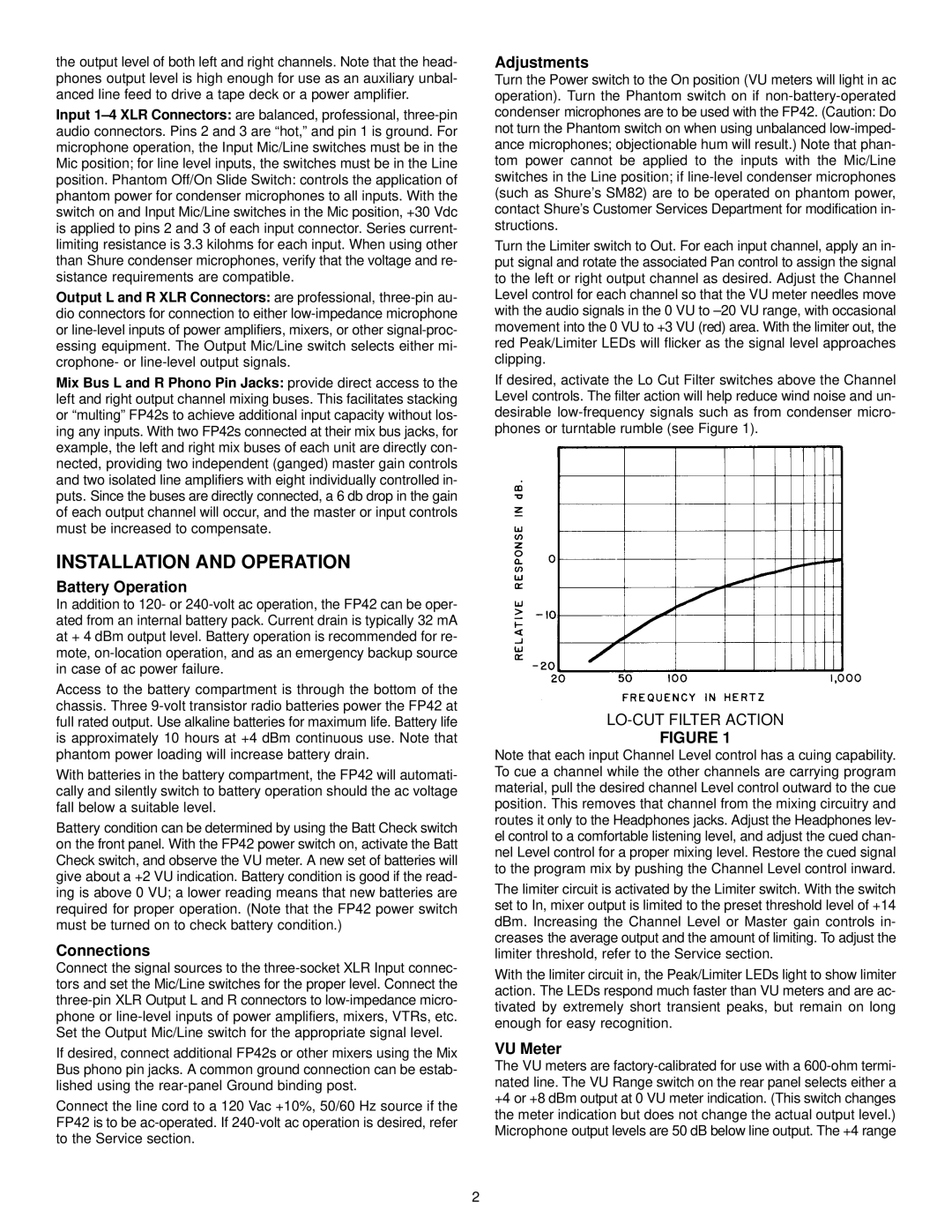
the output level of both left and right channels. Note that the head- phones output level is high enough for use as an auxiliary unbal- anced line feed to drive a tape deck or a power amplifier.
Input
Output L and R XLR Connectors: are professional,
Mix Bus L and R Phono Pin Jacks: provide direct access to the left and right output channel mixing buses. This facilitates stacking or “multing” FP42s to achieve additional input capacity without los- ing any inputs. With two FP42s connected at their mix bus jacks, for example, the left and right mix buses of each unit are directly con- nected, providing two independent (ganged) master gain controls and two isolated line amplifiers with eight individually controlled in- puts. Since the buses are directly connected, a 6 db drop in the gain of each output channel will occur, and the master or input controls must be increased to compensate.
INSTALLATION AND OPERATION
Battery Operation
In addition to 120- or
Access to the battery compartment is through the bottom of the chassis. Three
With batteries in the battery compartment, the FP42 will automati- cally and silently switch to battery operation should the ac voltage fall below a suitable level.
Battery condition can be determined by using the Batt Check switch on the front panel. With the FP42 power switch on, activate the Batt Check switch, and observe the VU meter. A new set of batteries will give about a +2 VU indication. Battery condition is good if the read- ing is above 0 VU; a lower reading means that new batteries are required for proper operation. (Note that the FP42 power switch must be turned on to check battery condition.)
Connections
Connect the signal sources to the
If desired, connect additional FP42s or other mixers using the Mix Bus phono pin jacks. A common ground connection can be estab- lished using the
Connect the line cord to a 120 Vac +10%, 50/60 Hz source if the FP42 is to be
Adjustments
Turn the Power switch to the On position (VU meters will light in ac operation). Turn the Phantom switch on if
Turn the Limiter switch to Out. For each input channel, apply an in- put signal and rotate the associated Pan control to assign the signal to the left or right output channel as desired. Adjust the Channel Level control for each channel so that the VU meter needles move with the audio signals in the 0 VU to
If desired, activate the Lo Cut Filter switches above the Channel Level controls. The filter action will help reduce wind noise and un- desirable
LO-CUT FILTER ACTION
FIGURE 1
Note that each input Channel Level control has a cuing capability. To cue a channel while the other channels are carrying program material, pull the desired channel Level control outward to the cue position. This removes that channel from the mixing circuitry and routes it only to the Headphones jacks. Adjust the Headphones lev- el control to a comfortable listening level, and adjust the cued chan- nel Level control for a proper mixing level. Restore the cued signal to the program mix by pushing the Channel Level control inward.
The limiter circuit is activated by the Limiter switch. With the switch set to In, mixer output is limited to the preset threshold level of +14 dBm. Increasing the Channel Level or Master gain controls in- creases the average output and the amount of limiting. To adjust the limiter threshold, refer to the Service section.
With the limiter circuit in, the Peak/Limiter LEDs light to show limiter action. The LEDs respond much faster than VU meters and are ac- tivated by extremely short transient peaks, but remain on long enough for easy recognition.
VU Meter
The VU meters are
2
